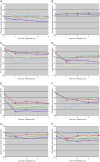Health related quality of life for men treated for localized prostate cancer with long-term followup
- PMID: 20399462
- PMCID: PMC4575915
- DOI: 10.1016/j.juro.2010.02.013
Health related quality of life for men treated for localized prostate cancer with long-term followup
Abstract
Purpose: Men who undergo primary treatment for prostate cancer can expect changes in health related quality of life. Long-term changes after treatment are not yet fully understood. We characterized health related quality of life evolution from baseline to 4 years after treatment.
Materials and methods: We identified 1,269 men in CaPSURE who underwent primary treatment for clinically localized prostate cancer and completed followup health related quality of life questionnaires for at least 4 years. The men underwent radical prostatectomy, external beam radiotherapy, brachytherapy, combined external beam radiotherapy/brachytherapy or androgen deprivation therapy. Health related quality of life was measured using patient reported questionnaires. Effects of select covariates on quality of life were measured with a multivariate mixed model.
Results: Age at diagnosis, time from treatment and primary treatment were significant predictors of health related quality of life in all domains (p <0.05) except primary treatment on sexual bother. Men who underwent radical prostatectomy experienced the most pronounced worsening urinary function but also had the greatest recovery. All treatments worsened urinary bother, and sexual function and bother. All forms of radiotherapy moderately worsened bowel function and bother after treatment but eventual recovery to baseline was noted.
Conclusions: Age at diagnosis, time from treatment and primary treatment type affect health related quality of life. Treatment has a greater impact on disease specific than general health related quality of life. All treatments adversely affect urinary and sexual function. Most adverse changes develop immediately after treatment. Recovery occurs mostly within 2 years after treatment with little change beyond 3 years.
Copyright 2010 American Urological Association Education and Research, Inc. Published by Elsevier Inc. All rights reserved.
Figures

References
-
- Barry MJ, Albertsen PC, Bagshaw MA, et al. Outcomes for men with clinically nonmetastatic prostate carcinoma managed with radical prostatectomy, external beam radiotherapy, or expectant management: a retrospective analysis. Cancer. 2001;91:2302. - PubMed
-
- Lu-Yao GL, Yao SL. Population-based study of long-term survival in patients with clinically localised prostate cancer. Lancet. 1997;349:906. - PubMed
-
- Merglen A, Schmidlin F, Fioretta G, et al. Short-and long-term mortality with localized prostate cancer. Arch Intern Med. 2007;167:1944. - PubMed
-
- Litwin MS, Gore JL, Kwan L, et al. Quality of life after surgery, external beam irradiation, or brachytherapy for early-stage prostate cancer. Cancer. 2007;109:2239. - PubMed
Publication types
MeSH terms
Grants and funding
LinkOut - more resources
Full Text Sources
Medical

